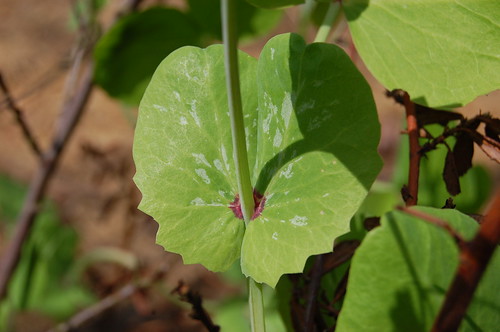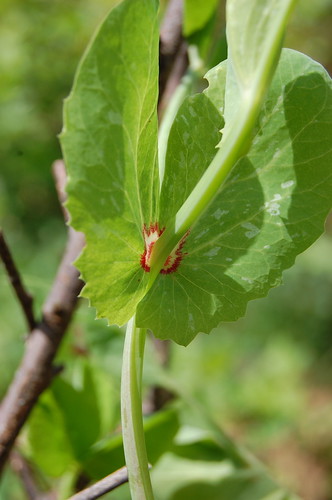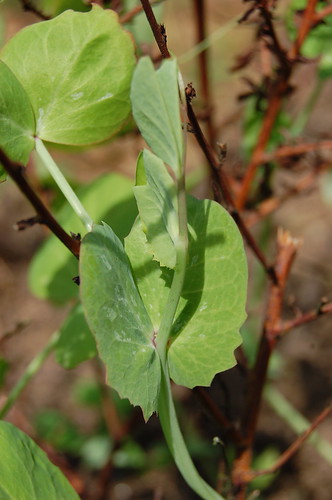I don't read up as much as I should on pea genetics, but it certainly seems that the genes controlling the expression of colour in different parts of the plant tend to come as a package deal. From what I have bothered to read, I know that there are distinct and separate genes for pink splodges in the leaf axil, for purple or pink bicolour flowers, purple seedcoat speckles and purple pods - plus another gene which switches colour production on or off for the whole plant. The purple pod genes (there's actually two of those) are often inherited separately, but the rest seem always to go together. It's quite useful in some ways, because the axil splodge enables me to predict flower colour several weeks before they flower, or even to select for flower colour before I sow by going for the dark-coloured or speckled seeds. Although they're different genes they are presumably all squidged right up together on the same chromosome.
The axillary splodges are made by just one major gene, but there is a lot of subtle variation in how they are expressed.

Golden Sweet x Kent Blue F1
I made this hybrid in 2007 and the seeds have been sitting around ever since waiting for me to do something with them. The plants have a very intense blotch in the leaf axil, with a distinctively purple hue.
I'm not sure what I'm expecting to get from this hybrid, it's one of my suck-it-and-see crosses. Both parents are heritage varieties of some considerable vintage, which usually makes for interesting hybrids. Certain traits can be predicted in the F1: Golden Sweet is yellow podded, but there is no trace of yellow colouring in these F1 plants because it's a recessive trait and will be hiding for now. I expect to see yellow pods in a quarter of the F2 offspring next year, but not in these. Bicolour purple flowers are pretty much a certainty though, as both parent varieties have them. But Kent Blue has the unusual feature of changing its flower colour. The flowers open as normal mauve and maroon bicolours, but within a day or so they change to a sky blue and midnight blue bicolour. They also have very pronounced veining on the back of the petals, which is very pretty. Whether these traits will show up in the F1 flowers remains to be seen. I'm also curious to see what happens to the pods in terms of width and knobbliness. Both parents are edible podded varieties of a slightly primitive type (i.e. not as sleek and fibre-free as a modern cultivar). There are two recessive genes responsible for edible pods and the way they interact is quite crucial. Depending on which ones I have here, the hybrid may be completely fibre-free (better than either parent) or they might be totally inedible. It may seem strange that you can cross two edible-podded varieties together and end up with inedible pods, but it does happen (and has happened to me!) It's one of the endearing little quirks you get in a multi-factor cross with recessive genes.

Golden Sweet x Carruthers' Purple Podded F1
This hybrid is the parent of my red-podded pea. The red pods showed up in a small proportion of the F2 seeds, and so I'm growing another batch of F1 plants in order to produce more F2 seed, in the hope of getting some red edible podded recombos. These plants are from the original batch of seeds from the cross I made in 2007, and despite the seed being three years old they are showing considerable hybrid vigour, overtaking all the other peas in the garden.
The axillary pigmentation is very flamboyant, forming two distinct pinky-red rings with a white band in the middle, and something of a Bowie lightning flash at the top. This is an exaggerated form of the double axil ring inherited from Golden Sweet.
As I've already grown some of these F1 seeds I know what to expect from them, but a lot of it is easy to predict anyway. Both parents have purple flowers, which are dominant, so the F1 will have them too. Both parents are tall, and that's also dominant. Carruthers' Purple Podded passes on the two dominant genes for purple pods, so the F1 hybrid will have purple pods. Golden Sweet contributes the yellow-pod gene, but that's recessive, so none in the F1 generation. It's when these genes segregate out in the F2 that things get exciting, because when the two purple pod genes happen to come together with the yellow pod gene, that's the magic formula that gives red pods.

Alderman x Salmon-Flowered F1
Another 2007 hybrid which has sat in a box and never been grown before. This one is a cross between one of the best heritage shelling peas and a botanical curiosity, so it is venturing into uncharted territory. See how subdued the axil colour is on this one. It's a soft muted pink and sits tightly within the axil without spreading out into the leaf. The upper stem and tendrils have a rosy blush too, and the leaves have red edges. These traits are all inherited from dad, Salmon-Flowered. There are no obvious colour genes in Alderman, though it may have some unexpressed ones lurking in its genome waiting to burst forth in an unexpected carnival. On the surface it's a fairly normal green-podded pea, chosen for its excellent flavour.
What makes Salmon-Flowered such a curiosity is that it's an umbellatum type pea. These were popular in past centuries, once known as crown peas, but they are now rare. Instead of producing flowers and pods up the length of the stem, they bear all their bounty in a whopping great clump at the top. They look so different from normal peas that they were formerly classified as a separate species, Pisum umbellatum. This has now been dropped, however, since it was discovered that they are botanically the same as other domestic peas and their bizarre form is merely the result of a combination of three recessive genes, whose exact function and interaction is still not fully understood.
Well I don't understand them either, but as they are all recessive I can probably assume that none of the umbellatum traits will be apparent in an F1 hybrid. Even in the F2, it may be a very small minority class (where all three recessives combine). Never mind, there is other excitement to discover. Such as flower colour. Alderman is a white-flowered pea, and white flowers are recessive. Salmon-Flowered is ... er ... salmon flowered (two-tone pale pink and salmon pink) which I believe is also recessive. What happens when I cross these two shrinking violets? God knows. I'll have to wait and see. They may be pink, they may be white - or they may be neither. As I said above, a multi-factor cross with recessive genes can throw up surprising and counterintuitive results. I'm looking forward to seeing what turns up.
9 comments:
Being a great lover of garden art, I enjoyed going through your blog. Keep on posting.
You write brilliantly - I think I actually understood most of that! No guarantee I could remember it or even have an articulate conversation about it, but I'm finding this fascinating.
What I love however, is you are showing that any of us could do this, thanks :)
My F2s are shaping up to have some white but mainly coloured flowers. As you know, the green only plants are looking like they'll be white flowered and the 'splodge' plants have a distinct look of colour in the only buds I can see.
However, what interests me is that my Goldensweets, on the next 'climbng frame', have splodges, bicolour flowers but yellow pods, so the colouration in the plant won't necessarily show up in pod colour. They keep you guessing all along, don't they?
PS - go on Bilbo, you know you want to!
Love those leaf axil halos! I hadn't heard of the umbellatum peas before - I'm very intrigued. That characteristic could be nice for soup peas (intended for drying) if they would tend to mature seed all at the same time...
Oooh - I just found your article about the salmon flowered pea - http://www.daughterofthesoil.com/salmonflowered.html
Excellent!
Great stuff. Have you tried using parsley pea in any of your crosses? I think Alan Kapuler used it to create his hypertendril snap peas. It would be even better with bicoloured flowers and purple (or even red!) pods as a dwarf edible ornamental for container plantings. Got to be the pea for hanging baskets - I did grow it that way one year and it looked quite good.
Thanks Ann!
Bilbo - indeed anyone can breed their own plants, with or without a knowledge of genetics. All you need is an open mind and a blunt scalpel.
Kath - although there is a strong correlation between axil splodge and flower colour, the pod colour genes seem to be much more independent. There are a lot of Victorian varieties (like Carouby de Maussane and Bijou) which have pink splodge/purple flowers with green pods. The purple pod genes are either on a different chromosome or far enough away on the same chromosome to enable them to assort independently.
Leigh - you have it exactly right - Salmon-Flowered does mature all its pods at once. The flowers all bloom together in a massive posy, which looks stunning but is over in a few days!
Rhizowen - funnily enough I am about to try some Parsley Pea crosses this year, and Alan Kapuler very kindly sent me some seeds of his own Parsley Pea breeding line. It's going to be fun to experiment with those.
You're a trouble-maker (and I mean that in the nicest way!).
I'm growing some HSL Climbing Pea - Robinson, a gift from Hazel at the Hill, and jumped up and down in glee today to find a little axil splodge ....
Hi! Could you please tell me where did you read about genetic of green peas?
Thanks a lot!, L.
Post a Comment